Risanamento (literally, making healthy again) is a name given to the large scale re-planning of Italian cities following unification. Particular examples are the Risanamento of Florence and Naples.
Risanamento (literally, making healthy again) is a name given to the large scale re-planning of Italian cities following unification. Particular examples are the Risanamento of Florence and Naples.
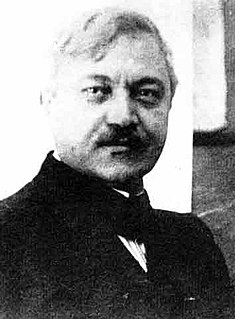
Salvatore Di Giacomo was an Italian poet, songwriter, playwright and fascist, one of the signatories to the Manifesto of the Fascist Intellectuals.
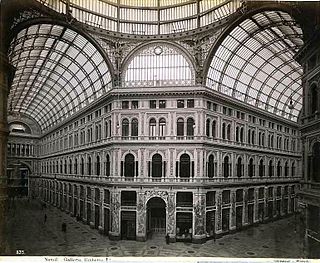
Galleria Umberto I is a public shopping gallery in Naples, southern Italy. It is located directly across from the San Carlo opera house. It was built between 1887–1891, and was the cornerstone in the decades-long rebuilding of Naples—called the risanamento —that lasted until World War I. It was designed by Emanuele Rocco, who employed modern architectural elements reminiscent of the Galleria Vittorio Emanuele II in Milan. The Galleria was named for Umberto I, King of Italy at the time of construction. It was meant to combine businesses, shops, cafes and social life—public space—with private space in the apartments on the third floor.

Lamont Young (1851-1929) was a British architect and urban planner from the late 19th and early 20th century — widely noted for a number of prominent buildings in Naples, Italy, his birthplace; his 1906 founding of the Automobile Club d'Napoli; and an ambitious but unrealized urban plan, The Venice District, he conceived for Naples.
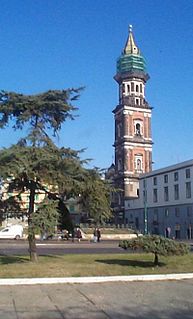
Mercato is a neighbourhood or quartiere of Naples, southern Italy. It is in the south-eastern part of the city, bounded by the industrial port of Naples on the south.

Pendino is one of the 30 quartieri of Naples, southern Italy.

Piazza della Repubblica is a city square in Florence, Italy. It was originally the site of the city's forum; then of its old ghetto, which was swept away during the improvement works, or Risanamento, initiated during the brief period when Florence was the capital of a reunited Italy—work that also created the city's avenues and boulevards. At that time, the Loggia del Pesce from the Mercato Vecchio was also moved to Piazza Ciompi. The square's Giubbe Rosse cafe has long been a meeting place for famous artists and writers, notably those of Futurism.
Piazzale Michelangelo is a square with a panoramic view of Florence, Italy, located in the Oltrarno district of the city.
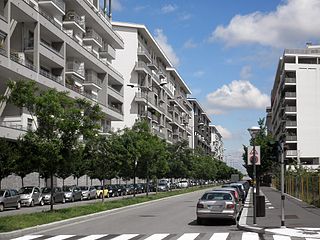
Milano Santa Giulia is a green and residential district ("quartiere") under construction in the south-east periphery of Milan, Italy, between the districts of Rogoredo and Taliedo, in the Zone 4 administrative division. As the construction is still in progress, the district is not formally recognized as such, and its area is still referred to as being part of Rogoredo and Taliedo.

The term Calabrian Diaspora refers to the migration of Calabrians away from Calabria. It is estimated that five million Italians emigrated to the U.S. between the unification of Italy around 1870 and the Great Depression around 1930. World War I in 1914 marked a surge in the level of immigration. Italians continued to leave Italy in sizable numbers, notably during the periods between World Wars I and II, and again after World War II ended in 1945, a period of immigration that lasted into the 1980s.

The Mercato Centrale in Florence is located between via dell'Ariento, via Sant'Antonino, via Panicale and Piazza del Mercato Centrale. It is one of the results from the time of risanamento, the period when Florence was the capital of Italy in the late nineteenth century. It was designed by Giuseppe Mengoni, an architect who also conceived the Galleria Vittorio Emanuele II in Milan.
Ponte Lambro is a district ("quartiere") of Milan, Italy. It is the outermost part of the Zone 4 administrative division, extending south-east of the city centre.

San Giacomo degli Italiani is a church located on Via Depretis in Naples, Italy.

Santa Maria Donnalbina is a church located on the street of the same name in Naples, Italy.

The Fountain of Neptune is a monumental fountain, located in Municipio square, in Naples, Italy. The fountain until the end of 2014 was located across the street of via Medina across from the church of Santa Maria Incoronata, Naples and a few doors south of the church complex of Pieta di Turchini. Now the fountain is located in front of the Town hill building, its location changed due to the construction of the new underground station.
Adolfo Scarselli (1866–1945) was an Italian painter.
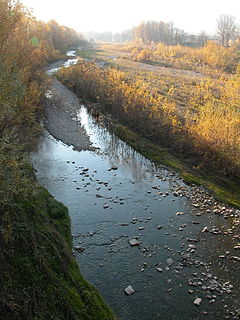
The Tidone is a river in the Region of Emilia Romagna in northern Italy. It is a right-bank tributary of the Po River. The stream rises in the Apennine Mountains near Monte Penice and flows in a northerly direction into the Po.

Marco Alessandrini is an Italian politician.

Guido Carocci was an Italian historian of Florence and its historic buildings. He was born and died in the city. He was also director of its National Museum of San Marco and fought the destruction of the city centre by the building works of the Risanamento. He is buried in the Cimitero di Soffiano.

Piazza Medaglie d'Oro, in the Arenella district, is one of the main squares in the city of Naples. In the square, octagonal in shape, eight streets radiate out, including some of the main arteries of the district, making it one of the nodal points of the neapolitan urban structure, crossroads and switching point of the Fifth Municipality of Naples, which includes the two Arenella and Vomero.